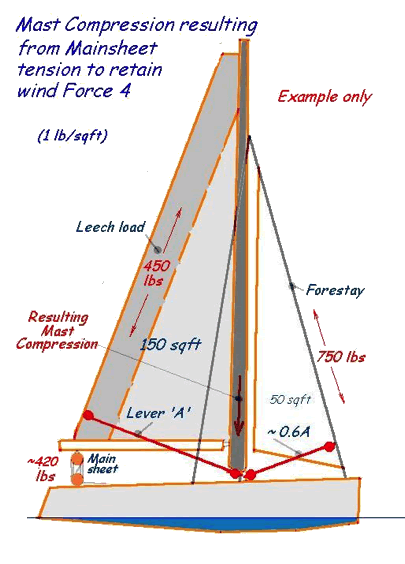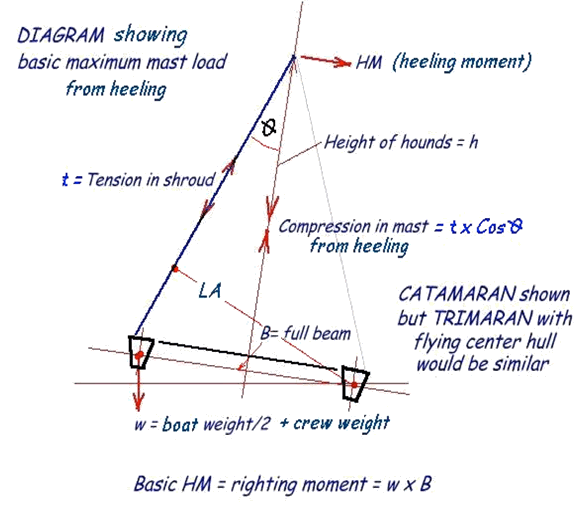


Rigging and Mast Loads simplified - — a fresh approach perhaps?
As I receive quite a few questions on this subject, I thought I would share with readers my own approach on this potentially complex subject in as much as small multihulls are concerned. My aim, as always, is to ‘simplify to the essentials’, in order to get practical values that I can work with and that make logical sense. Occasionally, too much science gets in the way of that goal ;-)
So first, perhaps we can agree on this. Regardless of how and where the wind hits the sails or waves hit the boat, the resulting forces are only transmitted between the rig and the boat via a few strong connection points. Only the mast can take compression ... the rest are all loose cables that will only work in tension. And, as the leeward shroud will typically be slack under high load conditions and the jib sheet takes and shares a load that mostly transfers to the forestay, we really only need to consider 4 main attachments: the mast, the forestay, a weather shroud and the mainsheet.
Next, I would consider that these forces, when at their maximum, will be applied via various combinations, from both the front and the side of the boat, so for this simple method of evaluation, we only need consider these two cases.
Regardless of how, where or at what angle the wind hits, wind forces from the mainsail will all be controlled, transferred and hopefully limited, by the mainsheet. So let’s first estimate what these might be, by working through sample figures for a small trimaran.
Main Sheet load: In a good force 4 wind that will likely be the maximum before reefing, the average wind pressure is about 1 lb/sqft** (see added note below).
So if we take the mainsail area of say 150 sqft, that sail would then be taking approx. 150 lbs of wind load. I have found, for small multis in the 15-23ft range, that in order to keep the leech aggressively straight and flat, one requires a download along the leech (via the mainsheet) of about 3 times that nominal wind load … so giving 450 lbs in this example. So let’s now look at the sailplan in profile, to see what load that puts on the forestay and mast.

By comparing the lever arms of the leech load, we can see that the forestay load to resist this pull will be about 450/0.6 or 750 lbs. If the leech load is at 20 deg off the vertical, then the vertical mainsheet load will be 450 x Cos 20° or 420 lbs maximum (assuming that the mainsheet is attached close to the mainsheet clew).
(Note: Lever arms should be measured perpendicular to the leech and forestay that carry the main loads).
So if we use a 5: 1 mainsheet, we will have a max pull on the line of about 85 lbs ... which is acceptable as an absolute maximum – being as most conditions will not get close to this. A 6:1 would further reduce this load but at the expense of more line and slower trimming.
(Cleats that still release under such high loads are recommended for this, such as a ‘Spinlock’ rocker cleat).
If the forestay is at 15 deg to the vertical, then the maximum forestay tension of 750 lbs., will result in a vertical mast compression of 750 x Cos 15° or about 720lbs. Add to this the vertical component of the mainsheet load and this will result in a combined vertical compression on the mast of about 720 + 420 = 1140 lbs. from mainsail sheeting.
So now lets’ look at the transverse loads with the boat ‘head-on’, to review what loads are coming to the mast as the maximum heeling & balancing righting moment is applied.
Let’s consider that in this assumed max. wind-load condition, the boat is now half out-of-the-water, with the crew on the windward hull … a typical and reasonable scenario for a force-4 gust with full sail. In this case, we can forget the actual wind load itself, as the tension in the windward shroud is created by the Heeling Moment and will be equal to, the Righting Moment divided by the shroud lever arm (LA)… at 90 deg to the shroud.
 The Righting Moment = [the beam (hull-to-hull centers) x ½ the boat weight], PLUS [the crew x their distance from the leeward hull]. As the lever arm (LA), will likely be less than the full beam from the leeward hull, this will slightly increase the shroud tension relative to the weight applied vertically, so divide the total Righting Mt. by that ‘LA’ value, to find the maximum shroud tension.
The Righting Moment = [the beam (hull-to-hull centers) x ½ the boat weight], PLUS [the crew x their distance from the leeward hull]. As the lever arm (LA), will likely be less than the full beam from the leeward hull, this will slightly increase the shroud tension relative to the weight applied vertically, so divide the total Righting Mt. by that ‘LA’ value, to find the maximum shroud tension.
Technically, the Righting Moment of the boat is: Boat Weight x Lever to the center of gravity, which in this case, is effectively, the same as that given above.
We all know that the broader the spread of the shrouds, the less shroud tension there will be – one of the advantages of a wide multihull. So measure that angle with the mast and then multiply ‘the cosine value of that angle’ by the shroud load, to find the compression imposed on the mast by the heeling/righting force. Let’s say the angle is 20°. If this boat weighed 420 lbs and the crew of say 300 lbs were over the outboard hull, then the basic heeling moment would be: (420/2 + 300) x B, and dividing that sum by the lever arm LA would give the tension in the shroud … say 560 lbs. So additional vertical mast compression from this heeling force would then be 560 lbs x Cos 20°, or about 520 lbs.
If we now add the compression load from the mainsheet trimming, to that apparent when heeled, we would then have a total mast compressive load of about 1660lbs.
(With most sound softwoods giving at least 1500lbs/sqin in compression parallel to the grain, this should be no problem for even a wood mast, provided it is well designed and put together. But the slenderness of the mast mnst also be respected, as if the unsupported length (height) exceeds the geometric radius of gyration of the mast section by over 120,, the allowable stress starts to drop fast. See more here.)
All these values might be further increased due to potential slamming in waves, but as most fine-hulled multihulls will cushion that fairly well, about a 30% increase would work for me for a small recreational craft, though I'd suggest adding 100% for boats going offshore and even more for long-distance cruisers.
From the above values, one can now select suitable fittings such as the mainsheet traveler and jib furlers etc … and also design track attachments and shroud chainplates etc.
For a reasonably long life and extra security, I would personally select fittings that give a breaking load of about 3 times the figures calculated above. For example: 750 x 3 = 2250 lbs., so a Breaking Load of 1100kg for the Barton furlers, should work fine.
Although the above is a serious simplification of forces on a sailing multihull and rig, it gives a practical way for calculating the loads that are needed for mast & fitting selection etc. on small multihulls under 8m, as targeted here.
mike waters, n.a. … April 2014
.
Added Note re Design Sail Loads for different sized boats: ....... added Jan 2022
While designing a new Emergency MainSheet Release (EMR) for SeaSafetyTech ... it was appreciated that larger boats may accept proportionally higher sail loadings than the smaller boats generally considered for this website. In order to factor this into load calculations, a simple formula has been adopted that can be shared here. Rather than fixing design sail load at 1 lb/sft (given above) that is OK for boats up to about 23ft, this design load should be increased for larger boats and this formula does that.
Take the design pressure load in lbs/sqft as numerically equal to 1/20th the boat length (in feet), using a minimum of 1 lb/sqft for boats under 20ft. This will double the design sail load per sqft for a 40 footer and triple it for a 60 footer, which is considered reasonable, as larger boats may reef at a higher wind speed and their sheer mass will impact loads applied by adding to the time and extent of load application.
.
"New articles, comments and references will be added periodically as new questions are answered and other info comes in relative to this subject, so you're invited to revisit and participate." —webmaster
"See the Copyright Information & Legal Disclaimer page for copyright info and use of ANY part of this text or article"
Copyright © 2012-22 mike waters